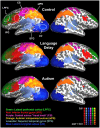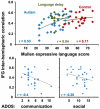Disrupted neural synchronization in toddlers with autism
- PMID: 21689606
- PMCID: PMC3119852
- DOI: 10.1016/j.neuron.2011.04.018
Disrupted neural synchronization in toddlers with autism
Abstract
Autism is often described as a disorder of neural synchronization. However, it is unknown how early in development synchronization abnormalities emerge and whether they are related to the development of early autistic behavioral symptoms. Here, we show that disrupted synchronization is evident in the spontaneous cortical activity of naturally sleeping toddlers with autism, but not in toddlers with language delay or typical development. Toddlers with autism exhibited significantly weaker interhemispheric synchronization (i.e., weak "functional connectivity" across the two hemispheres) in putative language areas. The strength of synchronization was positively correlated with verbal ability and negatively correlated with autism severity, and it enabled identification of the majority of autistic toddlers (72%) with high accuracy (84%). Disrupted cortical synchronization, therefore, appears to be a notable characteristic of autism neurophysiology that is evident at very early stages of autism development.
Copyright © 2011 Elsevier Inc. All rights reserved.
Figures




References
-
- Alexander AL, Lee JE, Lazar M, Boudos R, DuBray MB, Oakes TR, Miller JN, Lu J, Jeong EK, McMahon WM, et al. Diffusion tensor imaging of the corpus callosum in Autism. Neuroimage. 2007;34:61–73. - PubMed
-
- Ben Bashat D, Kronfeld-Duenias V, Zachor DA, Ekstein PM, Hendler T, Tarrasch R, Even A, Levy Y, Ben Sira L. Accelerated maturation of white matter in young children with autism: a high b value DWI study. Neuroimage. 2007;37:40–47. - PubMed
-
- Birn RM, Diamond JB, Smith MA, Bandettini PA. Separating respiratory-variation-related fluctuations from neuronal-activity-related fluctuations in fMRI. Neuroimage. 2006;31:1536–1548. - PubMed
Publication types
MeSH terms
Grants and funding
LinkOut - more resources
Full Text Sources
Other Literature Sources

